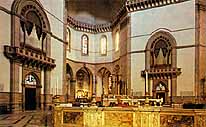
The Chancel and the Sacristies
The interior of the Cathedral contains two sacristies behind the main altar, called "of the Canonici" (or old sacristy) and "of the Messe" (or new sacristy), where Lorenzo the Magnificent hid on Easter morning in 1478 to escape from the assassins who had just murdered his brother Giuliano. The "Pazzi Plot", which was an attempt to kill the two young Medici princes during the mass in the Cathedral, was also foiled thanks to the quick reaction of Lorenzo's friend Agnolo Poliziano, who pushed him into the sacristy, barricaded the door and held out with a few friends until all the conspiritors had fled, after being set upon in their turn by the infuriated public in the church.
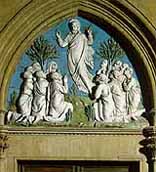
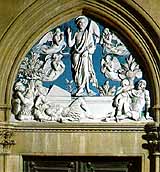
Luca della Robbia, lunette in the Sacresty
The sacristy doors are surmounted with the glazed terracotta lunettes of the Ascension (old sacristy) and the Resurrection (new sacristy) by Luca della Robbia. The artist was also commissioned to carry out the two portals in bronze, a contract that Donatello had already turned down, but only carried out the one for the new sacristy, ordered in 1446 but not cast until 1474, with the help of Michelozzo and Maso di Bartolomeo.
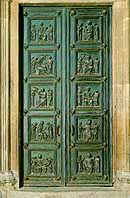
Luca della Robbia,
door of the Sacresty of the Messe
Two splendid marble Choir Lofts by Donatello (1433-38) and Luca della Robbia (1431-35, his first recorded work) were placed immediately above the sacristies until 1688; they are now exhibited in the Museum of the Opera del Duomo. These two masterpieces disclose the different currents developing from the interpretation of classical sculpture: Luca's balcony shows serenity, symmetry and love of detail, while Donatello's choir loft is already anti-classical, and his carefree putti chase each other in a Dionysian dance, reminding us of the late-antique art of the Imperial period.
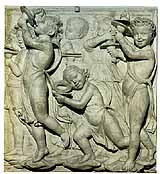
Luca
della Robbia,
detail of the Choir Loft
The Sacristy of the Messe contains some lovely inlaid cupboards by Giuliano
and Benedetto da Maiano (1463-65), which were designed by Brunelleschi himself
with other artists, among them Antonio del Pollaiolo and
Alessio Baldovinetti. Some of the other art works here include the head
of an angel by Mino da Fiesole and a lavabo by Andrea da Buggiano (1440),
Brunelleschi's adopted son.
